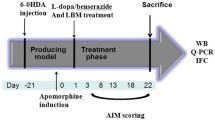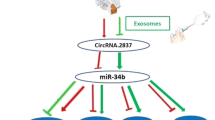Abstract
Biodegradable controlled-release microsphere systems made with the biocompatible biodegradable polyester excipient poly (dl-lactide-co-glycolide) constitute an exciting new technology for drug delivery to the central nervous system (CNS). Implantable controlled-release microspheres containing dopamine (DA) or norepinephrine (NE) provide a novel means to compare DA- or NE-induced restitution of function in unilateral 6-hydroxydopamine lesioned rats. A suspension of 3 μL of DA- or NE-containing microspheres or empty microspheres was implanted in 2 sites of the DA denervated striatum of rats previously unilaterally lesioned with 6-hydroxydopamine. Contralateral-rotational behavior induced by apomorphine was used as an index of lesion success and, following implantation of the microspheres, also as an index of functional recovery. Interestingly, both DA- and NE-microsphere-implanted rats displayed a 30–50% reduction in the number of apomorphine-induced rotations up to 8 wk postimplantation. Rats implanted with empty microspheres did not demonstrate significant changes in contralateral rotational behavior. Behavioral studies following implantation of a mixture of DA and NE microspheres revealed an 80% decrease in the number of apomorphine induced rotations up to 4 wk. On conclusion of the studies, immunocytochemical examination revealed growth of DA and tyrosine hydroxylase immunoreactive fibers in the striatum of DA and NE microsphere-implanted rats. Functional behavior appeared to correlate with the degree of fiber growth. Preliminary electron microscopic studies showed signs of axonal sprouting in the vicinity of the implanted microspheres. No growth was noted in rats implanted with empty microspheres. This report reviews the abilities of both microencapsulated NE and DA to assure functional recovery and to promote DA fiber (re)growth in parkinsonian rats. This novel means to deliver these substances to the central nervous system could be of therapeutic usefulness in Parkinson's disease.
Similar content being viewed by others
References
Birkmayer W. and Hornykiewicz O. (1961)Klin. Wochenschr. 73, 787.
Stahl S. M. (1984)J. Neural Transm. [Suppl.] 27, 123.
Bates I. P. (1984)Pharm. J. 30, 265.
Gardner C. R. (1985)Psychopharmacol. Bull.,21, 657.
Henderson N. L. (1983) inAnnual Reports in Medicinal Chemistry (Allen R. C., ed.), Academic, New York, pp. 275–284.
Bodor N. and Simpkins J. W. (1983)Science 221, 65.
Ommaya A. K. (1984)Cancer Drug Deliv. 1, 169.
Goldman P. N. (1982).New Engl. J. Med. 307, 286–290.
Bankiewicz K. S., Plunkett R. J., Kopin I. J., Jacobowitz D. M., London W. T., and Oldfield E. H. (1988) inTranslantation into the Mammalian CNS: Preclinical and Clinical Studies (Gash D. M. and Sladek J. R., eds.), Elsevier, Amsterdam, pp. 543–549.
Bohn M., Cupit L., Marciano F., and Gash D. M. (1987)Science 237, 913.
Dunnet S. B., Bjorklund A., Schmidt R., Stenevi U., and Iverson S. D. (1983)Acta Physiol Scand. Suppl.522, 29.
Freed W., Karoum F., Spoor E., Hoffer B., Olson L., Seiger A., and Wyatt R. (1981)Nature 292, 351.
Perlow M. J., Freed W. F., Hoffer B. J., Seiger A., Olson L., and Wyatt R. J. (1979)Science 204, 643.
Sladek J. R., Collins T. J., Haber S. N., Roth R. H., and Redmond D. E. (1986)Brain Res. Bull. 17, 809.
Strömberg I., Herrera-Marschitz M., Hultgren L., Ungerstedt U., and Olson L. (1984)Brain Res. 297, 41.
Björklund A., Lindvall O., Isacson O., Brundin P., Wictorin K., and Strecker R. E. (1987)TINS 10, 509.
Olson L., Backlund E. O., Sedvall G., Herrera-Marschitz M., Ungerstedt U., Stromberg I., Hoffer B., and Seiger A. (1984) inCatecholamines Neuropharmacology, and Central Nervous System Therapeutic Aspects, Part C. (Usdin E., Carlsson A., Dahlström A., and Engel J., eds.), Liss, New York, pp. 195–201.
Madrazo I., Drucker-Colin R., Diaz V., Martinez-Mata J., Torres C., and Becerril J. J. (1987)New Engl. J. Med.,316, 831.
Lindvall O., Brundin P., Widner H., Rehncrona S., Gustavii B., Frackowiac R., Leenders K., Sawle G., Rothwell J., Marsden D., and Bjorklund A. (1989)Science 247, 574.
Aebischer P., Tresco P., Sagen J., and Winn S. (1991)Brain Res. 560, 43.
During M. J., Freese A., Sabel W. M., Deutsch A., Roth R. H., and Langer R. (1989)Ann. Neurol.,25, 351.
Freese A., Sable B., Saltzman M., During M., and Langer R. (1989)Exp. Neurol. 103, 234.
Winn S. R., Wahlberg L., Tresco P. A., and Aebischer P. (1989)Exp. Neurol. 105, 244.
Becker J. B., Robinson T. E., Barton P., Sintov A., Siden R. and Levy R. J. (1990)Brain Res. 508, 60.
Tice T. R. and Tabibi E. (1992) inTreatise on Controlled Drug Delivery (Kydonieus A., ed.) Marcel Dekker, New York, pp. 315–339.
Tice T. R. and Cowsar D. R. (1984)Pharmaceut. Technol.,November, 26.
Eldridge J., Staas J., Merulbroek J., Tice T., and Gilley R. (1991)Infection and Immunity September, 2978.
Tice T., Mason D., and Gilley R. (1989) inNovel Drug Delivery and its Therapeutic Application (Prescott L. F. and Nimmo W., eds.), Wiley, New York, pp. 223–235.
Colpaert F. (1993) inNoradrenergic Mechanisms in Parkinson's Disease (Briley M and Marien M., eds.), CRC, Boca Raton, FL, pp. 225–254.
McRae A., Hjorth S., Mason D., Dillon L., and Tice T. (1990)J. Neural. Transm. Suppl. 29, 207.
McRae A., Hjorth S., Mason D. W., Dillon L., and Tice T. R. (1991)J. Neural. Transpl. 2, 165.
McRae-Degueurce A., Hjorth S., Dillon L., Mason D., and Tice T. (1988)Neurosci. Lett 92, 303.
McRae A., Hjorth S, Dahlström A, Dillon L., Mason D., and Tice T. (1992)Mol. Chem. Neuropathol. 16, 123.
Paxinos G and Watson C. (1982)The Rat Brain in Stereotaxic Coordinates, Academic, New York.
Ungerstedt U. (1971)Acta Physiol. Scand. Suppl. 367, 69.
Ungerstedt U., Herrera-Marschitz M., and Casa-Brugue M. (1981) inApomorphine and other Dopaminomimetics Vol 1. Basic Pharmacology (Gessa G. L. and Corsini G. U., eds.), Raven, New York, pp. 85–93.
Herrera-Marschitz M. and Ungerstedt U. (1984)Eur. J. Pharmacol. 98, 165.
McRae-Degueurce A., Rosengren L., Haglid K., Augustsson I., and Dahlström A. (1988)Acta Physiol. Scand. 133, 583.
Shu S. and Fan L. (1988)Neurosci. Lett. 85, 169.
Azmitia E. C. and Segal M. (1978)J. Comp. Neurol.,179, 641.
Fiandaca M. S., Kordower J. H., Hansen J. T., Jiao S. S., and Gash D. M. (1988)Exp. Neurol. 102, 76.
Herrera-Marschitz M., Stromberg I., Olsson D., Ungerstedt U., and Olson L. (1984)Brain Res. 297, 53.
Mavridis M., Millian M., and Colpaert F. (1990)Europ. J. Pharmacol. 183, 448.
Mavridis M., Colpaert F., and Millian M. (1991)Brain Res.,562, 216.
Richardson D. and Heath R. (1992)Acta Neurochirurgica 117, 124.
Felten D., Hallman H., and Jonsson G. (1982).J. Neurocytol. 11, 119.
Maeda T., Toyama M., and Shimizu N. (1974)Brain Res. 70, 515.
Pettigrew J. and Kasainatsu T. (1978)Nature 271, 761.
Pickel V., Segal M., and Bloom F. (1974).J. Comp. Neurol. 155, 43.
Tassin J., Reibaud M., Blanc G., Studler J., and Glowinski J. (1979)Neurosci.4, 1569.
Mavridis M., Degryse A., Lategan M., and Colpaert F. (1991)Neurosci.41, 507.
Langston W. (1985).Life Sci. 36, 201.
Hargraves R., and Freed W. J., (1987)Life Sci. 40, 959.
Furukawa Y., Furukawa S., Satoyoshi E., and Hayashi K. (1986)J. Biol. Chem. 261, 6039.
Author information
Authors and Affiliations
Rights and permissions
About this article
Cite this article
McRae, A., Ling, E.A., Hjorth, S. et al. Catecholamine-containing biodegradable microsphere implants as a novel approach in the treatment of CNS neurodegenerative disease. Mol Neurobiol 9, 191–205 (1994). https://doi.org/10.1007/BF02816119
Issue Date:
DOI: https://doi.org/10.1007/BF02816119




